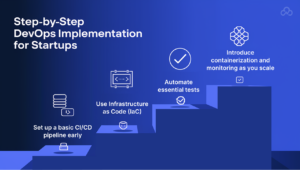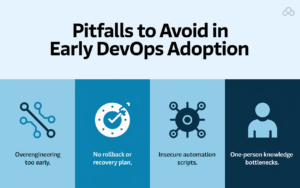DevOps Solutions Tailored for Startups

Let’s face it, startups don’t have the luxury of time. They move quickly, adjust constantly, and often operate with barely enough hands on deck. That kind of pace can drive momentum, sure, but without the right systems holding everything together? It gets messy fast. Broken code, late releases, frustrated users. We’ve seen it happen. That’s where DevOps startups begin to pull ahead. By blending development and operations from the start, these teams sidestep a lot of the chaos. It’s not just about speed, it’s about stability that doesn’t buckle under pressure.
Need numbers? The 2023 Puppet State of DevOps Report found that top-performing teams deploy code 208 times more often and recover from failure 106 times faster. If you’re trying to outpace competitors with half their resources, stats like that aren’t just nice to have, they’re your edge.
You don’t need to go all in on day one. Start small. Maybe that’s setting up your first CI/CD pipeline. Maybe it’s versioning your infrastructure with Terraform. You can always layer in more later, monitoring, containers, automation, whatever fits your growth stage.
This guide breaks it all down: how to begin, what tools to use, where to get support, and how real startups have scaled with DevOps. Whether you’re still building your MVP or scaling your first production system, it’s designed to meet you where you are, and help you move forward with fewer breakdowns.
1. Common Startup Challenges Without DevOps
Many startups focus on building their product. But behind the scenes, software delivery is often messy. Without DevOps, problems build up fast.
First, development and operations teams work in silos. Consequently, this creates confusion and slows things down. Developers build features, while operations handle deployments, but they rarely sync. As a result, bugs slip through, releases lag, and teams blame each other.
Second, deployments are manual. Startups without automation rely on scripts or terminal commands. One mistake can break production. Worse still, there’s no rollback plan. No logging. Just chaos.
Third, growth exposes the cracks. A manual process might work for 10 users, but not for 10,000. Without DevOps, scaling becomes fragile. Performance drops. Incidents rise. Users churn.
Also, debugging takes too long. Logs are scattered. Monitoring tools are missing. Teams waste hours finding the root of simple issues.
Data Point: According to Puppet, teams without DevOps take longer to deploy and recover. Meanwhile, DevOps startups enjoy faster releases and better uptime.
Quick Case:
- A B2B startup had a 5-day delay per release. After adding GitHub Actions and Terraform, they cut delivery time by 70%.
In summary, skipping DevOps creates risk. It slows your team, increases bugs, and hurts customer experience. Therefore, DevOps startups fix this by building the right workflow from day one.
2. Practical Startup DevOps Strategy
At first, many early-stage companies hesitate to adopt DevOps because it seems complex or resource-heavy. But DevOps doesn’t have to be all-or-nothing. For startup DevOps strategy, the best approach is often lean, modular, and iterative.
The key is to focus on foundational practices that solve immediate problems without overengineering the stack. By following a phased strategy, startups can reduce errors, speed up releases, and create infrastructure that scales with them.
3. Step-by-Step DevOps Implementation for Startups

-
Set up a basic CI/CD pipeline early
Start with a lightweight continuous integration and delivery tool. Platforms like GitHub Actions or GitLab CI/CD let teams test and deploy code automatically. This eliminates manual steps and catches integration issues before they hit production. -
Use Infrastructure as Code (IaC)
Managing servers manually leads to drift and hidden bugs. Tools like Terraform or Pulumi let teams define infrastructure using version-controlled code. With IaC, environments remain consistent across development, staging, and production. -
Automate essential tests
Even small teams can set up basic unit and smoke tests. These automated checks run after each code push, reducing the chances of broken features reaching users. Eventually, you can expand testing to include integration and end-to-end flows. -
Introduce containerization and monitoring as you scale
Once your user base grows, consider Docker for packaging your applications. Combine it with managed Kubernetes services or lightweight orchestration tools. At this point, monitoring also becomes essential, Grafana and Prometheus offer startup-friendly options.
Real Startup Example
A fintech startup used Terraform and GitHub Actions to automate staging deployments. Before adopting DevOps, it took them two days to configure a new environment. After implementation, setup time dropped by 65%, and deployment errors were nearly eliminated.
Ultimately, DevOps startups succeed by starting small, measuring impact, and expanding deliberately. Instead of building a bloated toolchain, they focus on solving one workflow problem at a time. In the long run, this method ensures early wins while laying the groundwork for scalability.
4. Essential DevOps Tools for Startups
Choosing the right tools is critical for any startup adopting DevOps. However, with limited time and budget, it’s important to select tools that offer a strong return on investment, both in performance and scalability. Thankfully, many platforms provide free tiers, open-source options, or startup-friendly pricing.
Below is a breakdown of core DevOps tools every startup should consider, based on function and suitability for lean development teams.
Recommended Tools for DevOps Startups
|
Category |
Tools |
Why It Matters |
|
CI/CD |
GitHub Actions, GitLab CI |
Enables automated testing and deployment with minimal setup and solid integrations |
|
Infrastructure as Code (IaC) |
Terraform, Pulumi |
Allows infrastructure to be versioned and reproducible across all environments |
|
Monitoring |
Grafana, Datadog |
Tracks system health and metrics; Datadog offers AI-powered alerts |
|
Containerization |
Docker, Kubernetes (Managed) |
Ensures consistent deployments; managed K8s scales easily without complex overhead |
|
Version Control |
Git (GitHub, Bitbucket) |
Foundation of modern DevOps workflows and collaboration |
Why These Tools Work for Startups
-
GitHub Actions integrates directly with repositories and is free for small teams.
-
Terraform helps manage cloud infrastructure with reusable code, ideal for reducing human error.
-
Grafana visualizes logs and metrics clearly, even without advanced setup.
-
Docker simplifies packaging, and using a managed Kubernetes service reduces the burden of orchestration.
-
Git is essential, it enables version control, collaboration, and traceability from day one.
Over time, as DevOps startups evolve, these tools provide flexibility without forcing premature scaling. Moreover, they support automation, monitoring, and team alignment, all without requiring a dedicated DevOps engineer at the start.
5. DevOps Managed Services: When and Why Startups Use Them
For many startups, building an internal DevOps team isn’t always practical. Hiring skilled engineers, maintaining infrastructure, and managing complex pipelines can divert resources away from product development. That’s where DevOps managed services come in.
In contrast, these services offer an efficient alternative. Instead of hiring full-time DevOps specialists, startups can outsource core infrastructure tasks to experienced providers who manage everything from CI/CD pipelines to monitoring and security compliance.
Key Benefits of DevOps Managed Services
-
Faster Setup: Get CI/CD, container orchestration, and IaC implemented in days, not weeks.
-
Expert Support: Access skilled engineers who specialize in cloud platforms, automation, and performance optimization.
-
Cost Efficiency: Pay only for what you need. Most services scale with your usage and team size.
-
24/7 Monitoring: Around-the-clock oversight ensures system reliability even when your internal team is offline.
-
Built-In Best Practices: Providers implement proven workflows, reducing the risk of security gaps or misconfigured systems.
According to Deloitte’s Tech Trends report, startups using DevOps managed services saw up to 40% faster time-to-market and significantly lower infrastructure overhead in their first 12 months.
When Should DevOps Startups Consider Managed Services?
-
You’re scaling quickly and can’t afford deployment failures
-
Your engineering team lacks dedicated DevOps experience
-
You’re entering regulated industries (e.g., fintech or healthcare) and need compliance-ready infrastructure
-
You want to focus on core product development, not pipeline maintenance
Ultimately, managed services allow DevOps startups to move faster with less risk. Instead of spending months building and maintaining delivery infrastructure, startups can launch with expert-backed systems, then decide later whether to scale internally.
6. Real Startup Case Studies & Cost-Benefit Overview
To better understand how DevOps strategies translate into real business value, let’s look at how early-stage companies applied these practices and what outcomes they achieved. As shown, these examples show how DevOps startups can move faster, recover quicker, and scale more efficiently, often with limited resources.
Case Study 1: SaaS Startup Scales CI/CD with Containers
A small SaaS company offering a data visualization platform struggled with inconsistent deployments and long QA cycles. They implemented GitLab CI/CD pipelines combined with Docker containers to standardize the build process.
- Result: Deployment frequency increased from biweekly to twice per week
- Impact: Customer-reported bugs dropped by 35% within two months
Case Study 2: HealthTech Firm Meets Compliance and Launches Faster
A HealthTech startup needed to deploy a HIPAA-compliant platform without an internal DevOps team. They partnered with a managed service provider that set up secure CI/CD workflows and infrastructure monitoring using Terraform and Datadog.
- Result: HIPAA-compliant infrastructure delivered in under 6 weeks
- Impact: Time-to-market was reduced by 40%, enabling faster onboarding of early clients
7. DevOps ROI for Startups
|
Benefit |
Impact |
|
Faster Releases |
3× more frequent deployments |
|
Reduced Downtime |
60% fewer service interruptions |
|
Lower Ops Overhead |
Up to 50% reduction in manual maintenance |
|
Improved Reliability |
35% fewer bug reports from end users |
Without a doubt, DevOps startups that adopt automation, monitoring, and infrastructure-as-code early are in a better position to scale sustainably. These gains aren’t just technical, they translate into faster growth, happier users, and lower support costs.
8. Pitfalls to Avoid in Early DevOps Adoption
While adopting DevOps can accelerate growth and improve stability, doing it wrong can waste resources and create new problems. Specifically, startups must be careful not to overcomplicate their setup or adopt tools without purpose. Below, we’ll cover some of the most common pitfalls DevOps startups should watch out for.

Overengineering Too Early
It’s tempting to mimic the complex architecture of large-scale tech companies. However, implementing multi-layered orchestration or advanced monitoring too soon can slow your team down. Instead, start with what solves your current problems, rather than what might be useful later.
No Rollback or Recovery Plan
Automation is great, until something breaks. Without a doubt, having no rollback strategy turns minor deployment issues into major outages. Therefore, startups should prioritize version control, automated backups, and staged rollouts to minimize risk and reduce downtime.
Insecure Automation Scripts
Automated workflows often require elevated permissions. Unfortunately, using unsecured scripts or storing credentials in plaintext increases the risk of exposure. To prevent this, use secrets management tools and follow the principle of least privilege throughout your automation process.
One-Person Knowledge Bottlenecks
In many early teams, one engineer handles “all the DevOps stuff.” If that person leaves, your entire delivery pipeline may grind to a halt. To mitigate this, ensure that documentation is thorough and that responsibilities are shared across multiple team members.
In summary, avoiding these early missteps helps DevOps startups stay focused on delivering features, not putting out fires. With the right balance of automation, security, and simplicity, your infrastructure becomes an enabler, not a liability.
9. Technical FAQs
Q1: Is CI/CD too complex for MVP-stage startups?
Actually, no, it’s quite the opposite. CI/CD is often one of the easiest wins you can get early on. Tools like GitHub Actions or GitLab CI are lightweight, integrate straight into your version control system, and don’t take much time to set up. Even a simple pipeline can handle basic builds and testing. For DevOps startups, this kind of automation keeps your pace consistent without adding extra load on the team.
Q2: When should we invest in automated testing?
As soon as you have something stable. That could mean your login screen works, or your API returns real data. Begin small, unit tests, smoke tests, whatever covers your app’s critical flows. As things grow, add integration tests and more advanced cases. The key is catching bugs before they ship. Automation does that, especially when wired into your CI/CD pipeline. It saves time later, even if it takes a bit upfront.
Q3: What’s the best approach to containerization early on?
Keep it simple. Start with Docker. Package your app and its dependencies in one clean unit. That way, you’ll avoid surprises when moving between dev and prod. You don’t need Kubernetes on day one. Stick to Dockerfiles and maybe a docker-compose setup. Once your load increases, or if you need high availability, you can look into managed Kubernetes (EKS, GKE, etc.). But early on? Just make it portable and predictable.
Q4: Do DevOps tools have startup-friendly pricing models?
Yes, and many of the best ones are free to start with. GitHub Actions, Terraform (open-source), Grafana, Docker, they all offer generous usage for small teams. When you’re ready to scale, services like Datadog or AWS offer usage-based pricing, so you’re not paying for more than you need. DevOps startups can get a lot done before spending anything serious.
These questions reflect what most early-stage teams run into. The answers aren’t always complex. But the sooner you start thinking about stability and automation, the easier your future will be.
10. Start Small, Scale DevOps as You Grow
Startups don’t get timeouts. You’re either building, fixing, or falling behind. And when your dev and ops efforts don’t talk to each other, the gaps show, slow releases, broken deployments, and poor user experience.
That’s where DevOps fits in. It’s not about becoming “enterprise-ready” overnight. It’s about setting a foundation now, while things are still scrappy.
Set up a CI/CD pipeline. Version your infrastructure. Automate your basic tests. That’s more than enough to start. Later, you can layer in containers, observability, and tighter security, whatever makes sense for where you’re heading.
Whether you do it in-house or partner with a managed service, the goal stays the same: move fast, stay stable, and be ready to scale. Because in a startup, every edge matters. And a good DevOps setup? That’s a real one.
Do you like to read more educational content? Read our blogs at Cloudastra Technologies or contact us for business enquiry at Cloudastra Contact Us